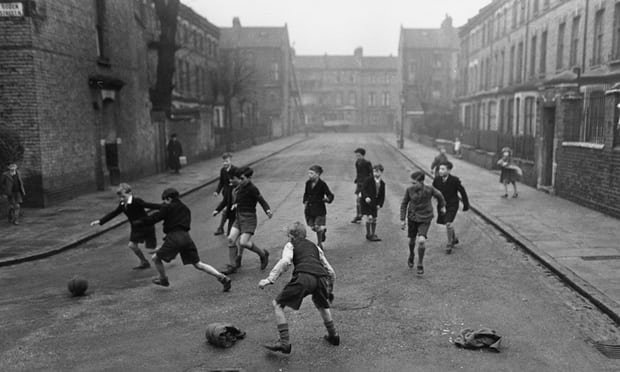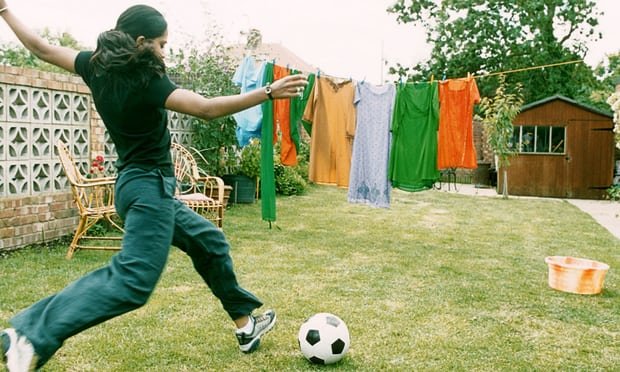A history of the genre, from early boys’ school stories to modern fiction, to celebrate FA Cup final day.

When did writing about football become a respectable activity? In 1992, the year in which Nick Hornby produced Fever Pitch, his trail-blazing account of a fraught quarter-century spent following Arsenal? Or 1993, when Hornby assembled a collection of essays (My Favourite Year) and thereby authenticated the work of what became known as the “soccerati” – broadsheet-haunting literary lads whose partiality for, say, Newcastle United was as strong as their hankering for Proust or Norman Mailer? Or maybe 1996, when a Sunday newspaper persuaded a be-scarfed AS Byatt to attend an England game at the Euros? Or even 1997, which brought the unveiling of Simon Kuper’s distinctly up-market football bi-annual, whose influence was out of all proportion to its brief lifespan (four issues, 1997-99) and meagre sales, and those involved included Roddy Doyle, Harry Pearson and Jim White?
The question of respectability is more important than it sounds: even in the mid-90s, when arts journalists were falling over themselves to unpick the aesthetic tapestry of the beautiful game, a faint air of snobbery hung over the depiction of football in print. In a novel or a short story, the scent of pained disparagement grew stronger still. Twenty years ago, for example, I published a novel whose sub-plot took in the misfortunes of a struggling west London football club named Walham Town. Among other stabs at verisimilitude, it ran to faithful reproductions of the kind of chants then issuing from the terraces at lower-league grounds. There followed a correspondence in the TLS over whether the Walham fans would actually have yelled the words “XYZ is a homosexual” and whether the stress would have been on the first or second O.
This reluctance to admit that a football match, with its 22 players, its thousands of spectators and its garnish of moral, mythical and even political endeavour, makes an ideal backdrop for a novel is all the more curious given soccer’s ability to infiltrate British literature at a fairly early stage. After all, Arnold Bennett’s The Card (1910) features a game, while PG Wodehouse’s Psmith in the City, published in the same year, hinges on the efforts of Psmith and Mike Jackson, its two bank clerk heroes to worm their way into the affections of a superior by feigning an interest in the prospects of Manchester United. It is from the golf-fancying and cricket-obsessed Wodehouse that we begin to appreciate quite how dramatically football had begun to colonise the national landscape at the beginning of the 20th century, leaching into its figurative language and gingering up its street-corner slang: Mike’s slovenly landlady is, for instance, shown dribbling a piece of fluff under the bed in “the manner of a professional footballer”, and the first response of a bystander when a fight threatens to break out at a political meeting is to shout “Play up the Arsenal”.
The first great wave of football fiction, lasting from about the 1890s to the 1930s, took the form of boys’ school stories, in which sport was there to teach moral lessons. My soccer-fixated father left me a shelf of them – brisk, no nonsense tales with titles such as Strickland of the Sixth or The Fellows of Ten Trees School where malingering “slack” houses are exhorted to renew themselves by entering for the school challenge cup, idle boys borne away by the ethical whirlwind of “team spirit” and attempted pitch invasions quelled by fresh-faced team captains handing out socks on the jaw.
Strickland’s real-life, public-school attending equivalent would, of course, have played rugby. The audience for boys’ school stories, alternatively, was an aspirational band of working-class and lower-middle-class youngsters who wanted to read about games that they themselves enjoyed.
At the same time, the conceptual underpinning of Strickland’s heroics on the playing fields of Havenhall school is exactly the same as in a bona-fide soccer classic such as Gordon Williams and Terry Venables’ They Used to Play on Grass (1973). For a football novel, you swiftly deduce, is never simply about football. It may feature a 20-page description of a cup final or abstruse jargon about Christmas tree formations and flat back fours; but at its core is likely to uncoil a devious, or not so devious, little parable about class or social change or moral imperative.
JL Carr’s How Steeple Sinderby Wanderers Won the FA Cup (1975), in which a village side triumphs at Wembley, might seem like an exercise in wish-fulfilment, but beneath the banter runs a pointed dispatch from an older provincial England slowly receding beneath the consumer-materialist tide.
The same point can be made of Nalinaksha Bhattacharya’s wonderful Hem and Football (1992), transferred to film as Bend It Like Beckham. An ornament of the first Bengali professional club for women, urged on by the Marxist coach Miss Nag (“the whole thing only makes sense as we consider ourselves as proletarians and our opponents as the bourgeoisie”), Hemprova, its teenage heroine, is quietly trying to detach herself from the stultifying straitjacket of family life and social expectation.
Meanwhile, there lurks a problem that any soccer writer from Carr and Bhattacharya to Bill Naughton’s tale of penalty area retribution The Goalkeeper’s Revenge will eventually have to address: football, as imagined by nearly every writer who approaches it, is essentially a romantic activity, set in a landscape of moral conflict (the diminutive winger trying to evade the hulking full-back, the plucky League Two outfit trying to outdo the behemoths of the Premier League). And it is also a physical obstacle course, in which tantalising skill and brute strength go arm in arm and moral feeling is ripe to be elbowed aside by ruptured cruciate ligaments and the reek of embrocation.
The book that comes closest to harmonising these two elements is Gordon Williams’s From Scenes Like These (1968) – not strictly speaking a football novel, as only a handful of its 300 or so pages takes place on the greensward, but setting some of the dilemmas of fictive reportage in sharp relief. Duncan “Dunky” Logan, its 15-year-old farm-labouring hero, who plays midfield for a West of Scotland amateur side, has grown up with a Boy’s Own Paper attitude to football while matter-of-factly accepting some of its physical realities (“At school it was all sportsmanship. You didn’t play to win, you were told off for fouling … But once you were out in real football it was different”). Once Dunky takes the field, for hard-as-nails Ayrshire hopefuls Cartneuk, Williams (who a year or so before had ghost-written Bobby Moore’s autobiography) opts for a peculiar twinned stream-of-consciousness, in which one part of Dunky’s mind seems to be following the game, making instant decisions about to react to its incidental challenges, while the other reflects, contextualises, talks back and urges on (“Don’t care if you get hurt. Only get hurt if you go in half-hearted. Do or die”). Appropriately enough, Dunky’s career ends shortly after he smashes into an opposing inside-left, breaks his own nose, the other player’s arm and has two of his front teeth kicked out in reparation.
The novelty of From Scenes Like These, shortlisted for the first Booker prize, is that sport occupies a central part in its protagonist’s life rather than being winched in as an incidental back-drop. For while postwar British fiction carries a wide range of footballing reference points – Alan Sillitoe’s short story “The Match”, say, set mostly on the terrace at a Notts County game, or BS Johnson’s experimental novel The Unfortunates, which contains some fragments of an Observer match report – hardly any of it starts from the premise that the game is interesting in itself. Keith Talent’s attendance at QPR fixtures in Martin Amis’s London Fields (1989) is largely an excuse for Amis to be funny about working-class footballers with names like Sylvester Dragon and Lee Fredge.

The influence of that 90s surge in book-world fascination with the game, however, has worked its effect, and the past decade and a half has been full of novels in which football is woven into the heart of the action to explore some wider political or sociological point: Anthony Cartwright’s Heartland (2009), for example, where a match between a Black Country park side and a local Muslim team echoes some of the uncertainties of Blair-era multicultural Britain; the same author’s Iron Towns (2016), where a once-promising trainee is found coming to terms with a much less enticing future; or David Peace’s incantatory Bill Shankly novel Red or Dead (2013), which elevates the progress of Liverpool FC in the 1960s and 70s to a mythical level.
And all this is to ignore a burgeoning world of young adult fiction, much of it written by women and, following the lead of Hem and Football, featuring girls’ teams. More recently, Ross Raisin’s A Natural (2017) might be taken as an example of just how far the football novel has come in its 120-year lifespan. Tom, a former top-flight trainee now engaged by some League Two also-rans, is neither a symbol of the unravelling national fabric nor a mythological icon, but a much more downbeat figure trying to come to terms with his sexuality.
Ultimately, A Natural makes a conceptual leap that most old-style football fiction laboured to achieve: in the end, its characters are as important as the milieu that tethers them and what emerges, once the last ball has been smashed into the net, is an exceptionally good novel, which just happens to take place on a football pitch. #B7
Please kindly follow me @kofpato for great sportsmanship.
Hell of a story man, keep up the good work! Upvoted and resteemed
Thanks bro